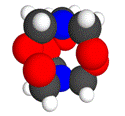Chemistry, Department of: Faculty Series

Gerard S. Harbison Publications
Document Type
Article
Date of this Version
7-1-1994
Citation
Published by American Institute of Physics
Journal of Chemical Physics (July 1, 1994) 101(1)
Abstract
The deuterium nuclear magnetic resonance (NMR) powder spectra of methyl groups at ambient temperatures are invariably averaged by rotation or hopping about the C3 axis. The canonical result for a perfectly threefold symmetric methyl is an axially symmetric Pake doublet whose splitting, in the case of perfect tetrahedral angles around the group, is averaged by a factor of exactly three. However, deuterium NMR spectra of methyl groups are often somewhat axially asymmetric, indicating a significant deviation either of the methyl group, or of its environment, from threefold symmetry. Previous explanations for this phenomenon have hinged on either an additional motional mechanism along a different axis, or on a perturbation of the field gradient around the methyl group by electronegative groups. We propose a simpler explanation; it may arise in a distortion of the methyl geometry ‘itself, so that the group no longer has perfect rotational symmetry. We analyze some experimental examples of distorted methyls, and compare the extent of distortion required by the NMR data with those observed in published neutron structures.


Comments
Copyright ©1994, American Institute of Physics. Used by permission